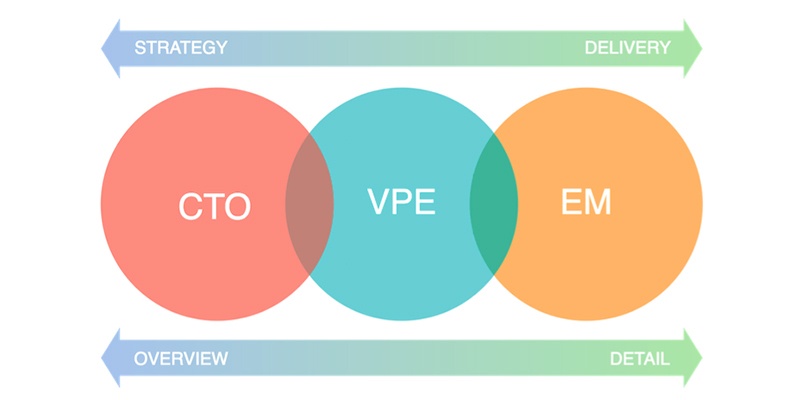Titles mean different things to different people and can be defined differently from one company to the next. Titles may even be redefined as a company evolves. Every company’s DNA is unique, so when clients come to Riviera Partners asking for help hiring a CTO or VP Engineering, we first help them define the role (not the title) they are hiring for.
What problem are you solving with this hire?
When defining the role, consider the problem your company is trying to solve with this hire.
Ask questions like:
- What do I need this person to achieve in their first 12 months on the job?
- What are the most critical problems I need them to solve?
- When is the right time to make this hire?
Different circumstances lead to hiring a new CTO. Growth (or lack thereof) or management skills could come into play. Your co-founding CTO may not be the CTO your company needs five years in. You’re in a different leg of the relay race, you may need a different kind of runner.
I was fortunate to work with my friend Daniel Doubrovkine on his search for Artsy’s VP Engineering. I love this blog post, which shares Daniel’s journey (and incredibly detailed Slack activity log) that led him to decide he needed to hire a VP Engineering. He also describes how he divided responsibilities between the CTO and VP Engineering.

VPE vs CTO
If your company is looking for a very technical CTO, you may need to find someone who loves systems design, coding, and technical architecture. But, buyer beware! This person may be a great technical leader, but not so great at managing teams or people. The deepest thinkers in architecture are rarely excellent team leaders.
Depending on the size of your team (and your budget) you may then want to consider hiring a VP Engineering. This person manages the day-to-day operations of your engineering team. The VP Engineering should know who to hire, how to successfully recruit, and manage a team that can successfully work together.
At the highest level, the CTO typically ensures the technical approach is correct while the VP Engineering makes sure the team is working well together and your engineers are happy. It’s rare you will find one person who can do all of the technical and people management work really well. If they can, it eventually may become challenging for them to perform at their best when they are playing dual roles (especially as you’re scaling).
To help you decide which role you should be filling, asking the question “What problem am I solving with this hire?” will be supremely helpful for figuring out who to recruit. Werner Vogels, CTO of Amazon, recently tweeted some advice to engineering leaders “1) if you want to be a VP of Engineering focus on teams and people and how to make them successful 2) wanna be a CTO? Simplify. Focus on the business, what is the simplest, most robust Tech/Ops that makes the business succeed.”
Who does what?
Here’s a breakdown of the most common requirements and responsibilities I’ve seen for CTOs and VPEs. In some cases, tasks may be interchangeable or a CTO may assume some of the responsibilities I’m listing under VPE (and vice versa). Feel free to mix and match if you’re creating a job description.
I expect some will disagree with me given the complexity and wide ranging opinions on this topic. I’m always so curious to learn how others approach this divvying up of responsibilities. Tell me what you think and why in the comments!
CTO
- The technology visionary inside the company who lays the foundation of what should be built
- Partners with the CEO and other key stakeholders as an executive team member, internalizing product and company objectives and how that translates to technical strategy
- Leverages innovation and encourage the right amount of risk-taking to achieve goals
- Understands the long and short-term goals of the business, determine the right technology and approach to align with business goals
- Directs technical strategy, lead by influence and drive change
- Collaborates with marketing, finance, and other functions to help move the business forward
- Participates in investor meetings, representing the companies technical POV
- Makes decisions on buy vs build, onshore vs offshore, as well as vendor selection
- Participates in technical due diligence for M&A
- P & L responsibility
Technical CTO / Chief Architect
- Sets standards for how code is developed
- Has heavy influence on the technical strategy
- Participates in technical due diligence for potential M&A deals
- The strongest technologist in the organization and can make high-level architecture decisions, and determine technical strategy
- Internal voice for technology the company
VP Engineering
- Cares about the happiness, wellbeing and productivity of your engineering team; they’re a great people manager and they know how to motivate their team
- Creates cohesion between product and engineering teams, successfully executing on a product roadmap and vision
- Determines hiring plans, drive recruiting strategy, and interview process
- Uses best practices to build, lead, and develop a world class engineering team
- Experience creating an organizational structure and best practices
- Understands engineering brand, and how to create/evangelize that brand to attract top talent
- Uses the right amount of rigor, process and predictive delivery while managing daily execution
- Inspires the team, instill a sense of purpose.
- Creates autonomy while holding the team accountable
- Understands the tradeoffs between performance, delivery, reliability and scalability when considering business objectives and deadlines
As a caveat, I have seen companies hire a CTO who is technically credible but not close to the code. They can operate successfully doing many of the things I list under ‘CTO’ but they may not be the strongest technologist in the company. In this case, they may lean on Architects, Directors of Engineering, or other more qualified team members.
The stakes are high, how do you make this hire?
Daniel’s incredibly detailed post on how he ran an incredibly tight and efficient process for hiring a VPE while at Artsy is a terrific guide.
When designing the job description, create a list of the problems you’re trying to solve and rank them in order of importance. Identify which problems are crucial to your mission and business strategy, then weight the list.
Next, determine your requirements by aligning skills and/or characteristics with the weighted list of problems the person will be responsible for solving.
Your candidate won’t check every box, so get comfy making tradeoffs. Focus on the top three requirements in the search, with four or five being your tradeoffs and pluses.
Once you’ve got your job description, make sure everyone internally is aligned on what you’re hiring for and (more importantly) why you're hiring. Explain what the requirements are and why you’ve chosen them, as well as what the mandate for your new hire will be.
Be selective with whom you include in the interview process. As my mentor Mike Morell points out, “You can’t give everyone veto power or you end up with the average person everyone liked. You lose sight of what actually makes for a successful hire. This is almost always true when inexperienced members of the team are involved in hiring a leadership position.”
Ready, Set, Hire
Now that you have a clear path for figuring out the kind of person you need to round out your team, it’s time to do the work. Making the right hiring choice for the right reason positions you for success, so it’s important not to rush through the prep work. Taking care now makes the whole process easier.










